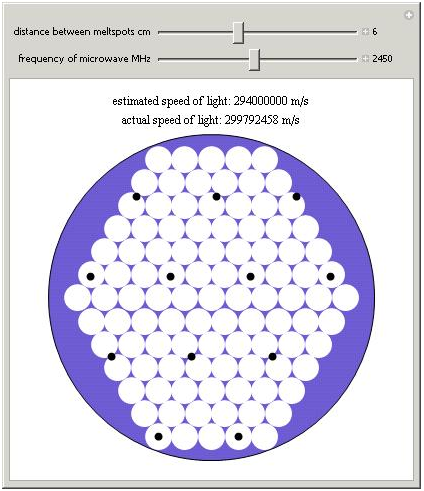|
|
|
|
..
A Take-Home Lab Robert H. Stauffer, Jr., Cimarron-Memorial High School, Las Vegas, Nevada, USA I have heard that at 16 years old, Albert Einstein constantly wondered what it would be like to ride on a beam of light. Students in physics always seem to be fascinated by the properties of light. However, speed-of-light demonstrations often require extensive preparation or expensive equipment. I have prepared a simple classroom demonstration that the students can also use as a take-home lab. The activity requires a microwave oven, a microwave-safe casserole dish, a bag of marshmallows, and a ruler. (The oven must be of the type that has no mechanical motion-no turntable or rotating mirror. If there is a turn-table, remove it first.) First, open the marshmallows and place them in the casserole dish, completely covering it with a layer one marshmallow thick. Next, put the dish of marshmallows in the microwave and cook on low heat. Microwaves do not cook evenly and the marshmallows will begin to melt at the hottest spots in the microwave. (I leaned this from our Food Science teacher Anita Cornwall.) Heat the marshmallows until they begin to melt in four or five different spots. Remove the dish from the microwave and observe the melted spots. Take the ruler and measure the distance between the melted spots. You will find that one distance repeats over and over. This distance will correspond to half the wavelength of the microwave, about 6 cm. Now turn the oven around and look for a small sign that gives you the frequency of the microwave. Most commercial microwaves operate at 2450 MHz. All you do now is multiply the frequency by the wavelength. The product is the speed of light. Example: Velocity = Frequency ´ Wavelength Velocity = 2450 MHz ´ 0.122 m Velocity = 2.99 ´ 108 m/s This works in my physics class, often with less than 5% error. Then the students can eat the marshmallows. (Reprinted with permission from The Physics Teacher, vol. 35, April 1997, p. 231. Copyright 1997 American Association of Physics Teachers ) |
|
| FAIR USE NOTICE: This page contains copyrighted material the use of which has not been specifically authorized by the copyright owner. Pegasus Research Consortium distributes this material without profit to those who have expressed a prior interest in receiving the included information for research and educational purposes. We believe this constitutes a fair use of any such copyrighted material as provided for in 17 U.S.C § 107. If you wish to use copyrighted material from this site for purposes of your own that go beyond fair use, you must obtain permission from the copyright owner. | |
|
|

